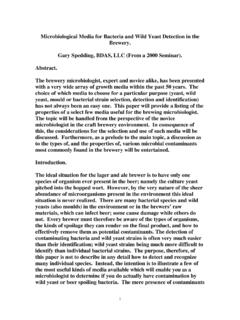Transcription of PRESERVATIVES - Food and Agriculture Organization
1 PRESERVATIVES . Food and Agriculture Organization of the United Nations PRESERVATIVES . Permitted levels additives to inhibit micro-organisms - CHEMICAL PRESERVATIVES - preservative Sulphites and sulphur dioxide. Sulphur dioxide gas and sodium or potassium sulphite, bisulphite or metabisulphite are the most common forms used. Commonly used levels Comments Fruit puree can be preserved by adding 600ppm sulphur dioxide (SO2) and sealing in drums. The semi-processed fruit can be stored for several months. Most of the SO2 that is absorbed during storage is lost during drying, but it is recommended that the puree is boiled before drying to reduce the levels of residual SO2.
2 preservative Sorbic acid . Sorbic acid and sodium and potassium sorbate are used to inhibit the growth of moulds and yeasts. The activity of sorbic acid increases as the pH decreases. Sorbic acid and its salts are tasteless and odourless when used at levels below Commonly used levels preservative Benzoic acid . Benzoic acid , in the form of sodium benzoate, is a widely used food preservative suitable for acid foods. Benzoic acid is often used in combination with sorbic acid at levels of to Commonly used levels preservative Citric acid . Citric acid is found naturally in citrus fruit. It is widely used in carbonated drinks and as an acidifier of foods.
3 It is less effective at controlling the growth of yeasts and mould than the other acids. Commonly used levels no limit PRESERVATIVES - permitted levels in fruit products The use of chemical PRESERVATIVES is regulated by maximum permitted levels. These amounts vary between countries. Processors should check with their local authorities for the local regulations and for the regulations in the country of sale. Chemical PRESERVATIVES cannot be used to cover up for poor quality raw materials. They are only added as a precaution to extend the shelf life of products by inhibiting microbial spoilage. Some chemical PRESERVATIVES can taint the flavour of fruit juices if the recommended level is exceeded.
4 Some consumers prefer to consume fruit juices with no chemical additives. They may be prepared to pay a premium for these products. additives to reduce PH. Organic acids, which are both naturally present in foods during fermentation or which are added to foods during processing, have been used for many years for food preservation. The most commonly used organic acids include citric, succinic, malic, tartaric, benzoic, lactic and propionic acids. Citric acid is found in citrus fruits. This acid is more effective than acetic and lactic acids at inhibiting the growth of thermophilic bacteria . Malic acid is widely found in fruit and vegetables.
5 It inhibits the growth of yeasts and some bacteria due to a decrease in pH. Tartaric acid is present in grapes and pineapples. Benzoic acid is the oldest and most widely used preservative . It occurs naturally in cranberries, raspberries, plums, prunes, cinnamon and cloves. Benzoic acid is primarily used as an antifungal agent in fruit-based and fruit beverages, fruit products, bakery products and margarine. lactic acid is not naturally present in foods, but is formed during fermentation of sugar by lactic acid bacteria . lactic acid inhibits the growth of spore forming bacteria at pH but does not affect the growth of yeast and moulds. Propionic acid occurs in foods by natural processing.
6 It is found in Swiss cheese at concentrations of up to 1%. It is effective against moulds and bacteria . Sulphuring or sulphiting Sulphur dioxide is used to preserve the colour and increase the shelf life of dried foods. There are two main methods of adding sulphur to foods - sulphuring and sulphiting. Sulphuring is more common for fruits and sulphiting for vegetables. Sulphuring uses rock sulphur which may be more readily available than sodium or potassium metabisulphite. One of the disadvantages of sulphiting is that it wets the fruit (the fruit is dipped into a solution of metabisulphite). This prolongs the drying period required. - Sulphuring - Sulphuring involves burning elemental sulphur in an enclosed chamber.
7 Sulphur dioxide gas is given off, which is absorbed by the food. The sulphur chamber is either a cabinet or tent in which perforated trays are stacked on top of each other. Food is placed on the trays inside the cabinet. The sulphur is placed in a box close to the trays and allowed to burn for 1-3 hours. A. simple sulphur tent can be made from a rack of shelves that are covered with an airtight polythene sheet. It is essential that the cover does not have holes and that it is firmly anchored down at the ground to prevent sulphur dioxide gas from escaping. The amount of sulphur used and the time of exposure depends on the commodity, its moisture content, the sizes of the pieces and the permitted final levels in the product.
8 For most fruits, 5-6g of sulphur per kg of food is adequate. For most vegetables, 10-12g sulphur per kg food is sufficient. Sulphuring should always be carried out in a well-ventilated place - preferably outdoors - as the fumes of burning sulphur are unpleasant and can be dangerous if inhaled. Sulphur dioxide gas is corrosive, therefore the cabinet used for sulphuring should not be made of metal. Wooden or plastic-coated metal shelves should be used within a wooden cabinet or a polythene tent. Sulphiting Sulphiting uses sulphite salts such as sodium or potassium sulphite or metabisulphite. The fruit or vegetable is either soaked in a sulphite solution or, if the commodity is being blanched in water, sulphite can be added to the blanching water.
9 Adding sulphite to the blanching water is attractive since it combines two operations into one. However, if the vegetables are steam blanched, or if they are not blanched at all, they need to be dipped into a sulphite solution. The strength of the sulphite solution and the dipping, spraying or blanching times depend on the type, size and composition of fruit or vegetable. Dipping and spraying sulphite are not generally recommended for small-scale processors. Immersion blanching in a sodium metabisulphite solution is the most appropriate method, provided that the chemicals are available locally. Sulphiting must be controlled accurately to obtain the correct levels of SO2 in the food.
10 Too much SO2 gives the food an unpleasant smell and may be illegal according to local permitted levels. The strength of sodium metabisulphite solution is expressed as parts per million (ppm). or mg per kg. As a conversion, 10,000ppm SO2 is equivalent to a 1% solution. of sodium metabisulphite dissolved in 1 litre of water will give 1000ppm ( ) SO2. The most practical way to make a sulphite solution is to prepare a stock solution of 8,000ppm ( ). This is done by dissolving 12g ( level teaspoons) sodium metabisulphite in 1 litre of water. The stock solution can be diluted by adding extra water to give weaker solutions. principles of pasteurisation Pasteurisation is a relatively mild form of heat treatment, generally at a temperature lower than the boiling point of water.

















